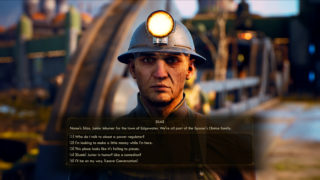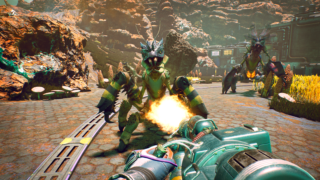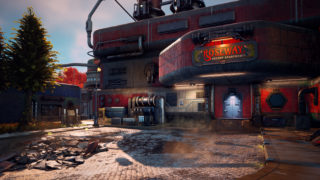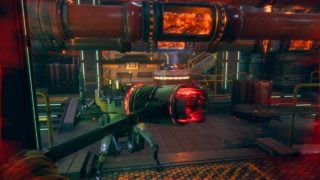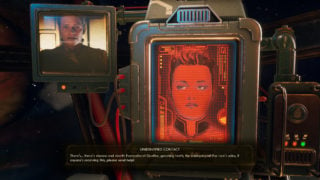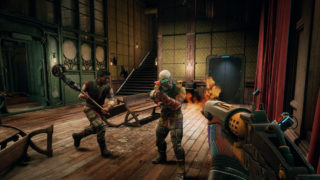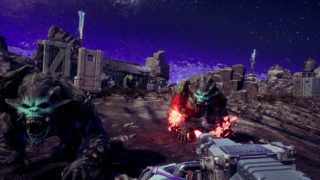Review: Outer Worlds isn’t Fallout – and that’s OK
Ignore the comparisons and a more distinctive adventure emerges
- Co-Director
- Tim Cain
- Key Credits
- Leonard Boyarsky (Co-Director), Daniel Alpert (Art director), Justin Bell (Audio director)

At the heart of The Outer Worlds’ tale lies a colony ship where earth’s greatest minds hibernate in cryo-sleep.

What would happen to Halcyon, a struggling corner of the galaxy, if you thawed them out? In some ways, it’s a question developers Obsidian have asked themselves, too: what if you took the original creators of 1997’s Fallout and put them back in the director’s chair of a modern, first-person RPG?
The answer, on the surface at least, is a game that looks and sounds and plays a lot like Bethesda‘s Fallout. It’s there in the CRT blur, and the keyboard clack, of computer terminals. It’s there in the way NPCs swivel to lock you into intense staring contests. There’s a variation on Fallout’s limb-targeting VATS, as time dilation slows shootouts to a crawl and lets you aim at your enemy’s fleshy bit of choice. It even has its own Vault Boy in the form of the moon-headed mascot of Spacer’s Choice, The Outer Worlds’ answer to Vault-Tec.
Considering Obsidian took the reins from Bethesda for Fallout: New Vegas, this isn’t a surprise. But it does give The Outer Worlds the feel of a sci-fi spin-off of an existing game, rather than an exciting, new toy in its own right. And with that comparison comes features where it feels over simplified, or more budget: the lack of a third-person option; hacking and lock-picking relegated to boring button presses rather than mini-games; tame gore effects that drain some of the fun from role-playing as a violent space bastard.
Of the differences, the most substantial, and damaging, is shifting from an open world to contained hubs, closer to Mass Effect’s handling of space. While this makes sense for a story that flits between a couple of planets, the regions feel small, with impassable cliffs and water bringing most exploring to a halt. It feels at odds with the promise of being a pioneer on strange new worlds. As a result it never convinces as a living place full of secrets, instead coming across as handcrafted levels where you discover exactly what the mission decides.
If you are looking for a spiritual successor to Bethesda’s Fallouts – specifically, an antidote to Fallout 76 – The Outer Worlds may disappoint. It isn’t a 100 hour epic. You can get to the end credits in 15, if you gobble through central story missions. And it lacks the playful discovery that keeps us excavating those sprawling maps. But it’s unfair to Obsidian to judge it by those standards. In bringing back Fallout’s original creators, Tim Cain and Leonard Boyarsky, it’s arguably trying to tap into a different style of RPG. Something more interesting.
What The Outer World lacks in geographic breadth, it makes up for in dramatic depth. This is a role-playing game that works hard to accommodate any role you choose to play. Want to be Han Solo? Bang points into handguns and a hefty dose of charming persuasion. Fancy yourself a ninja? Stealth, lockpicks and hacking let you run circles around hired goons. (It helps that The Outer Worlds lets you hide in long grass and better displays alert statuses – one area it easily trumps Fallout.)
“The Outer Worlds’ commitment to the viability of different approaches is impressive. At times it almost resembles a Deus Ex, as you infiltrate factories laced with hidden entrances, hackable robots, shadowy corners and the obligatory air vents.”
We’ve seen these kinds of differing RPG play styles before, sure, but The Outer Worlds’ commitment to the viability of different approaches is impressive. At times it almost resembles a Deus Ex, as you infiltrate factories laced with hidden entrances, hackable robots, shadowy corners and the obligatory air vents. But where that elastic design really shines is in conversation, and the way NPCs react and change course based on whatever freaky space hero (or villain) you bring to them.
More showstopping decisions include dialling down intelligence until you’re left with a Zapp Brannigan-ish space dunce, baffling everyone you meet with your sheer obliviousness. Or going rogue and grassing on allies to alienate half the galaxy and spend the game working for the baddies instead. These must see outcomes justify multiple playthroughs, but even the way tiny side mission conclusions can impact your reputation, and reflect in future interactions, shows the dizzying complexity beneath the game’s surface.

It’s all for nothing if the writing falls flat. The Outer Worlds isn’t as edgy as it thinks it is. Its ‘corporations are bad’ schtick is toothless in light of the heinous stuff filling real headlines. But there’s a warmth to its characters that cuts through the snark. Companions, in particular, really spark as they barge into dialogue or chat to each other. You’ll want to use replays to spend time with all of them, especially when you realise that bringing along your ship’s maintenance bot means he spends the entire game bellowing weird cleaning war cries.
In this light, the game’s relatively slim run-time – still a solid 35 or so hours if you diligently hunt side quests and aid companions – makes more sense. Instead of an open world, it’s a narrative petri dish, encouraging you to plug new decisions into a controlled environment to better study their spiralling outcomes. Admittedly, you’ll see through a few of its tricks on a second playthroughs – the central decision to side with good or evil takes you down a mostly similar path – but there are enough surprises to make it worthwhile.
“The Outer Worlds’s real challenge is getting over what it isn’t, to enjoy what it is. It’s a game that only reveals much of its cleverness over time.”
It’s also worth bumping the difficulty up if you’re at all familiar with the genre. The standard setting leans towards easy, with companions chewing through most enemies with ease. Of course, you may want to just enjoy the story, but without a bit of combat bite there’s less reason to dig into many of the game’s systems – its weapon upgrades, modding, etc. The Outer Worlds is a game about consequences, and raising the stakes, if only a notch, ensures those repercussions are properly felt.
The Outer Worlds’s real challenge is getting over what it isn’t, to enjoy what it is. It’s a game that only reveals much of its cleverness over time: both as events snowball, and as you discover the potential spread of multiple playthroughs. To discover those brains you have to look past limitations and accept this isn’t Galactic Fallout – you have to wait for Bethesda’s Starfield for that – and appreciate that this is a small slice of space with deep consequences. Manage that, and frosty first impressions thaw faster than a ship full of human popsicles.
Fallout similarities are distracting, but get into The Outer Worlds’ narrative meat and a more distinctive adventure emerges.
- Flexible story accommodates all kinds of heroes
- Enough variation to replay several times
- Stunted maps never convince as a living world
- Often feels like a budget Fallout
